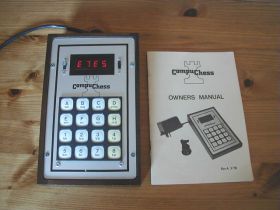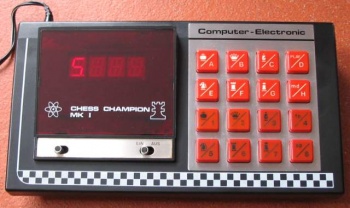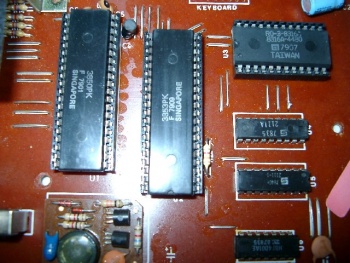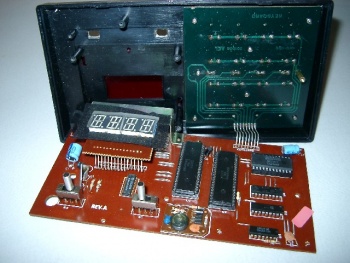CompuChess
| Compuchess | ||
|---|---|---|
 | ||
| Hersteller | Data Cash Systems / Staid Inc. | |
| Markteinführung | 1977 | |
| CElo | 985 | |
| Programmierer | Goodrich, David B. & Associates | |
| Prozessor | F8 (Fairchild 3850) | |
| Prozessortyp | 8 Bit | |
| Takt | 2 MHz | |
| RAM | 256 bytes | |
| ROM | 2 KB | |
| Bibliothek | None | |
| Einführungspreis | $159.95 | |
| Rechentiefe | ||
| BT-2450 | ||
| BT-2630 | ||
| Colditz | ||
| Verwandt | Novag Chess Champion MK I , JS&A Computer Chess | |
| Zugeingabe | 16 key Keypad | |
| Zugausgabe | LED display | |
| Display | 4 x 7-segment LEDs | |
| Stromversorgung | 12V DC 0.1A integral power supply | |
| Spielstufen | 6 | |
| Maße | 19.0 x 12.0 x 4.3 / no chessboard or pieces | |
| Sonstiges | ||
Compuchess: The Loser
In the race to be the first chess computer on sale to the public CompuChess lost out to the Fidelity Chess Challenger 1. In 1976 CompuChess was in the development stage at the same time as Chess Challenger. There was a chance that CompuChess would be the first dedicated chess computer to go on sale. However it took much longer to develop the program and then to manufacture the chess computer. So Chess Challenger appeared at the Chicago Consumer Electronics Show in January 1977 and was in the shops by Spring. CompuChess was not available to the public until the Autumn. Insult was then added to injury when another manufacturer copied the CompuChess program without permission and used it in their own chess computer. United States copyright law proved to be of no assistance and the CompuChess manufacturers lost their battle in court too.
New ROMs, New Products

In August 1976 the first ROM cartridge-based video game console was released for public sale. This was the Fairchild Video Entertainment System (or Channel F). The new ROM chips (EPROMS) had opened up the possibility for many new consumer products. As people used to say at the time "applications using this new technology are limited only by your imagination". Some people's imagination turned to developing a marketable chess computer.
First in line were Sid Samole and Ron Nelson. How they came to develop the Chess Challenger is well described in an article by Lev Alburt and Al Lawrence called "How About A Nice Game Of Chess? - Any Time" which you can find at ChessCafe.com [1]. Sid Samole was first to the market with a chess computer and his Fidelity company went on to be very successful throughout the 1980s.
The Compuchess Chess Computer
Data Cash Systems Inc. also started to develop a chess computer in mid 1976. They hired independant consultants, D. B. Goodrich & Associates of Largo, Florida, for the design and development of the chess program.
It is not known who the actual chess programmer was. Possibly David Goodrich himself? Suggestions that it was Peter Jennings seem to be wrong. In interviews Peter Jennings has never mentioned any involvement with CompuChess, prior to programming the Commodore Chessmate. His Microchess program was written for a 6502 based microcomputer and ported to a 8080 based microcomputer in 1977. The CompuChess has a Fairchild 3850 processor with a different architecture to the 6502 and 8080. The other early chess computer based on a Fairchild 3850 is the Chafitz Boris, which is now known to have been programmed by David Lindsay. Mike Johnson is another chess programmer known for his Fairchild chip programs. The CompuChess program was named the "Chess One-Move Calculation" program and perhaps should be acknowledged as the work of Goodrich, unless information to the contrary becomes available.
The chess computer is operated using a 16-key keypad with the computers moves and information displayed on a four digit LED display. By early chess computer standards operation is straightforward and flexible. There are six levels, four of which are usable for normal chess. You can set up problems such as Mate-in-2, alter the piece positions, and add and delete pieces. Playing a game of chess with CompuChess is easier than with the Fidelity Chess Challenger 1. Mistakes are recoverable, but CompuChess will also accept illegal moves.
Development of the chess program took from September 1976 until April 1977. The CompuChess was manufactured by Data Cash Systems Inc. but marketed by a company called Staid Inc., also of Largo, Florida. Available from November 1977 it sold over 2,500 units to the end of the year. The PCB and manual were revised in March 1978 and it is pictures of this Rev A version you see in this article. The relative success of the Compuchess resulted in the development of a CompuChess Second Edition.
The Court Case

In June 1978 the manufacturers of the CompuChess ROM, General Instruments Corporation, informed Data Cash Systems that they were producing a ROM for a company in Hong Kong which testing had shown to be identical to the CompuChess ROM. The new chess computer was being manufactured by Novag Industries, and their distributors in the USA were JS&A. Data Cash Systems were unsuccessful in stopping the manufacture and marketing of the JS&A Computer Chess, which was released for sale in the USA in late 1978. Shortly after this a law suit was filed alleging copyright infringement and unfair competition.
Unfortunately for Data Cash Systems their belief that their ROM could not be copied led to their copyright not being adequately protected. So they lost their court case , and then their appeal. The case has some importance in the history of computer program copyright law in the USA and is therefore documented on the internet. (Case notes) [2] (Appeal notes) [3]
The Clones
The court case established beyond doubt that the program in the CompuChess is exactly the same as the program in the JS&A Computer Chess and in the Novag Chess Champion MK I. As the computer processors are also the same the Mk I and JS&A are clones of CompuChess. In tests CompuChess plays enough identical moves in similar time (always 5% slower) to show that the chess program in the CompuChess and JS&A are the same. As the program is designed to chose randomly between moves of approximately equal value, no two games are likely to be exactly the same. A Novag Chess Champion MK I lookalike, known as the Videomaster Chess Champion, which was marketed by Waddingtons in the UK, moves roughly twice as quickly. This version was sold also as MK I with "Quick-Response".
The Compuchess Chips
These are the main components in the CompuChess Rev A PCB :-
Fairchild 3850PK - F8 CPU chip - date stamped 7744
Fairchild 3853PK - Static Memory Interface chip - date stamped 7804
NEC D2101AL-4 (x2) - Static RAM chips - 2 x (256 x 4 bits)
CMCSI/Staid 32014-4950 - Program ROM (2 KB) - date stamped 7749
Below (left) are pictures of the Novag Chess Champion MK I and on the right the CPU and ROM of the CompuChess.




